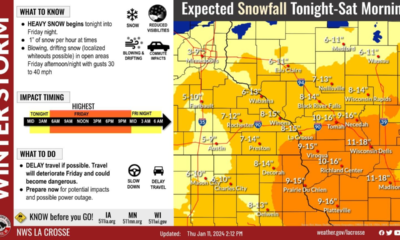Agriculture
Changing weather patterns impact fruit and vegetable production

Shifting weather patterns have led to new discussions about growing fruits and vegetables in climate change.
Natalie Hoidal and Annie Klodd both work as University of Minnesota Extension educators. Hoidal’s focus targets vegetable production, whereas Klodd’s specialty is fruit.
Looking back on weather records for Minnesota and Wisconsin, there have been noticeable changes in precipitation. Hoidal and Klodd said some key highlights show more intense precipitation whether it is rain or snow, but also warmer winters. Although we are receiving more water, they anticipated more time between rain events, meaning intense precipitation mixed with drought and dry periods.
Klodd said a common misconception is that new varieties of fruits and vegetables can be grown in the region because of warmer winters.
“That’s not the case,” Klodd said. “I think it would take a lot of years of climate change in order for us to start growing fruit varieties that we haven’t been growing before. We still do get really cold temperatures in the winter.”
Although winters have been warmer with fewer extreme cold events, temperatures drop 35 to 40 degrees below zero in some parts of the upper Midwest. There will be notable changes though, according to Klodd. Predictions show 27 fewer freeze days during the winter with earlier starts to spring.
An early spring may seem welcome, but warmer temperatures can cause early bud break, leaving them susceptible to frost damage if cold temperatures return. Some experienced producers use overhead irrigation to prevent frost damage with the idea that the frozen water will protect berries because it acts as an insulating layer.
“That’s pretty complicated, so I would encourage people to look up more information on that before trying it,” Klodd said.
Wet weather can also cause other disasters for fruit producers, which is why several switched to high tunnels production to keep diseases from strawberries or raspberries. Another recommendation was to keep rows between plants well mowed or use landscape fabric to keep humidity out of the system and prevent disease.
Vegetables are not immune to those challenges. Hoidal said one of the main challenges is excess water in the spring when people need to be in the fields which can hinder weed management.
“They can’t plant on time, which means weed pressure becomes more of a problem,” Hoidal said.
Increased disease pressure as well as physiological issues from fluctuating water levels are also concerns. High tunnels can be used for vegetable production on a small scale, but are too challenging for use in several acres.
“In general, I think really focusing on soil health and building up soil organic matter, keeping living roots in the soil, reducing tillage, those are ways to essentially increase the water holding capacity of our soils,” Hoidal said. “That also helps our soils hold onto nutrients better.”
She also recommended using different mulches. Plastic or tarps are common among farmers to place over beds to keep weeds down and prevent diseases that come with splashing soil.
Of course, as each farmer or grower knows, solutions will vary depending on each individual farm type and landscape. Natural Resources Conservation Services can offer solutions and cost-sharing programs to help find solutions tailored to individual situations.
Another resource is the University of Minnesota-Extension Farm Information Line 1-800-232-9077). It is a number that people with questions can call to speak with an extension educator or receive advice. That number will also help connect individuals facing financial or farm stress. Lastly, the Klodd and Hoidal produce a University of Minnesota Extension Fruit and Vegetable Newsletter. Those who subscribe can receive emails with information about what is happening in the fields.







